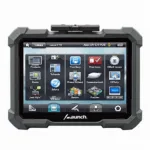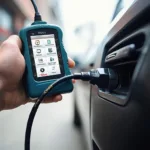All OBD2 protocols are the standardized communication languages used by your car’s onboard computer to talk to diagnostic tools, like OBD2 scanners. Understanding these protocols is key to effectively diagnosing and troubleshooting vehicle issues. This article dives deep into the world of OBD2 protocols, explaining what they are, how they work, and why they’re important for every car owner.
What are OBD2 Protocols?
OBD2, or On-Board Diagnostics II, is a standardized system that allows external devices to access a vehicle’s diagnostic information. At the heart of this system are the OBD2 protocols, which define how data is transmitted and received between the vehicle’s computer and the diagnostic tool. Think of them as the languages spoken between your car and your scanner. If your scanner doesn’t “speak” the right protocol, it won’t understand what your car is “saying.”
obd2 interface supports all obd2 protocols
Why are Different Protocols Necessary?
Different car manufacturers historically used different communication systems. Standardizing with OBD2 streamlined diagnostics, but variations still exist within the OBD2 framework. These variations are the different protocols, each designed to accommodate different vehicle makes, models, and years.
A Breakdown of All OBD2 Protocols
There are five main OBD2 protocols used in vehicles:
- SAE J1850 PWM (Pulse Width Modulation): Primarily used by Ford vehicles.
- SAE J1850 VPW (Variable Pulse Width): Commonly found in GM vehicles.
- ISO 9141-2: Typically used in European and Asian vehicles, particularly older models.
- ISO 14230-4 KWP2000 (Keyword Protocol 2000): Another protocol found in European and Asian vehicles.
- ISO 15765-4 CAN (Controller Area Network): The most modern protocol, increasingly prevalent in newer vehicles.
interface supports all obd2 protocols программа
How to Determine Your Car’s OBD2 Protocol
The easiest way to identify your car’s OBD2 protocol is to consult your vehicle’s owner’s manual. Alternatively, you can use an online OBD2 protocol lookup tool or check a label under the hood or on the driver-side doorjamb.
All OBD2 Protocols and Your Scanner
Choosing an OBD2 scanner that supports all obd2 protocols ensures compatibility with a wide range of vehicles. This is particularly important for mechanics or anyone who works with various makes and models.
“Investing in a scanner that supports all OBD2 protocols is essential for anyone serious about car diagnostics,” says automotive expert, Michael Stevens. “It saves you the hassle of dealing with compatibility issues and ensures you have the right tool for the job, regardless of the vehicle.”
elm327 interface supports all obd2 protocols
The Future of OBD2 Protocols
While CAN is currently the dominant protocol, the automotive industry is constantly evolving. Future developments in vehicle technology may lead to new and more advanced communication protocols.
Conclusion
Understanding all OBD2 protocols is crucial for effective vehicle diagnostics. By knowing the different protocols and ensuring your OBD2 scanner supports them, you’re equipped to tackle a wide range of automotive troubleshooting tasks. Choosing the right scanner empowers you to maintain your vehicle and stay ahead of potential problems.
elm327 mini interface supports all obd2 protocols
FAQ
-
What does OBD2 stand for?
- OBD2 stands for On-Board Diagnostics II.
-
Why is it important to know my car’s OBD2 protocol?
- Knowing your car’s OBD2 protocol ensures you choose a compatible diagnostic scanner.
-
Where can I find my car’s OBD2 protocol information?
- Check your owner’s manual, use an online lookup tool, or look for a label under the hood or on the driver-side doorjamb.
-
Do all OBD2 scanners support all protocols?
- No, not all scanners support all protocols. Look for a scanner that explicitly states it supports all five main OBD2 protocols.
-
What is the most common OBD2 protocol?
- Currently, CAN (Controller Area Network) is the most common and modern OBD2 protocol.
-
What if my scanner doesn’t support my car’s protocol?
- It won’t be able to communicate with your car’s computer and retrieve diagnostic information.
-
Are there any other OBD protocols besides the five main ones?
- While less common, there are some other protocols, but the five discussed cover the vast majority of vehicles.
For further assistance, please contact us via WhatsApp: +1(641)206-8880, Email: [email protected] or visit our office at 789 Elm Street, San Francisco, CA 94102, USA. We offer 24/7 customer support.

